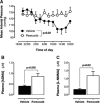Evidence that links loss of cyclooxygenase-2 with increased asymmetric dimethylarginine: novel explanation of cardiovascular side effects associated with anti-inflammatory drugs
- PMID: 25492024
- PMCID: PMC4768634
- DOI: 10.1161/CIRCULATIONAHA.114.011591
Evidence that links loss of cyclooxygenase-2 with increased asymmetric dimethylarginine: novel explanation of cardiovascular side effects associated with anti-inflammatory drugs
Abstract
Background: Cardiovascular side effects associated with cyclooxygenase-2 inhibitor drugs dominate clinical concern. Cyclooxygenase-2 is expressed in the renal medulla where inhibition causes fluid retention and increased blood pressure. However, the mechanisms linking cyclooxygenase-2 inhibition and cardiovascular events are unknown and no biomarkers have been identified.
Methods and results: Transcriptome analysis of wild-type and cyclooxygenase-2(-/-) mouse tissues revealed 1 gene altered in the heart and aorta, but >1000 genes altered in the renal medulla, including those regulating the endogenous nitric oxide synthase inhibitors asymmetrical dimethylarginine (ADMA) and monomethyl-l-arginine. Cyclo-oxygenase-2(-/-) mice had increased plasma levels of ADMA and monomethyl-l-arginine and reduced endothelial nitric oxide responses. These genes and methylarginines were not similarly altered in mice lacking prostacyclin receptors. Wild-type mice or human volunteers taking cyclooxygenase-2 inhibitors also showed increased plasma ADMA. Endothelial nitric oxide is cardio-protective, reducing thrombosis and atherosclerosis. Consequently, increased ADMA is associated with cardiovascular disease. Thus, our study identifies ADMA as a biomarker and mechanistic bridge between renal cyclooxygenase-2 inhibition and systemic vascular dysfunction with nonsteroidal anti-inflammatory drug usage.
Conclusions: We identify the endogenous endothelial nitric oxide synthase inhibitor ADMA as a biomarker and mechanistic bridge between renal cyclooxygenase-2 inhibition and systemic vascular dysfunction.
Keywords: endothelium; kidney; nitric oxide; pharmacology; prostaglandins.
© 2014 The Authors.
Figures





Comment in
-
Letter by Kruszelnicka et al regarding article, "evidence that links loss of cyclooxygenase-2 with increased asymmetric dimethylarginine: novel explanation of cardiovascular side effects associated with anti-inflammatory drugs".Circulation. 2015 Oct 27;132(17):e212. doi: 10.1161/CIRCULATIONAHA.115.015383. Circulation. 2015. PMID: 26503754 No abstract available.
-
Reply to letter regarding article, "evidence that links loss of cyclooxygenase-2 with increased asymmetric dimethylarginine: novel explanation of cardiovascular side effects associated with anti-inflammatory drugs".Circulation. 2015 Oct 27;132(17):e213-4. doi: 10.1161/CIRCULATIONAHA.115.017260. Circulation. 2015. PMID: 26503755 No abstract available.
Similar articles
-
Cyclooxygenase-2, Asymmetric Dimethylarginine, and the Cardiovascular Hazard From Nonsteroidal Anti-Inflammatory Drugs.Circulation. 2018 Nov 20;138(21):2367-2378. doi: 10.1161/CIRCULATIONAHA.118.033540. Circulation. 2018. PMID: 29930022 Free PMC article.
-
Reply to letter regarding article, "evidence that links loss of cyclooxygenase-2 with increased asymmetric dimethylarginine: novel explanation of cardiovascular side effects associated with anti-inflammatory drugs".Circulation. 2015 Oct 27;132(17):e213-4. doi: 10.1161/CIRCULATIONAHA.115.017260. Circulation. 2015. PMID: 26503755 No abstract available.
-
Letter by Kruszelnicka et al regarding article, "evidence that links loss of cyclooxygenase-2 with increased asymmetric dimethylarginine: novel explanation of cardiovascular side effects associated with anti-inflammatory drugs".Circulation. 2015 Oct 27;132(17):e212. doi: 10.1161/CIRCULATIONAHA.115.015383. Circulation. 2015. PMID: 26503754 No abstract available.
-
Asymmetric dimethylarginine, derangements of the endothelial nitric oxide synthase pathway, and cardiovascular diseases.Semin Thromb Hemost. 2000;26(5):539-45. doi: 10.1055/s-2000-13210. Semin Thromb Hemost. 2000. PMID: 11129410 Review.
-
Asymmetric dimethylarginine, an endogenous inhibitor of nitric oxide synthase, explains the "L-arginine paradox" and acts as a novel cardiovascular risk factor.J Nutr. 2004 Oct;134(10 Suppl):2842S-2847S; discussion 2853S. doi: 10.1093/jn/134.10.2842S. J Nutr. 2004. PMID: 15465797 Review.
Cited by
-
Eicosanoids, prostacyclin and cyclooxygenase in the cardiovascular system.Br J Pharmacol. 2019 Apr;176(8):1038-1050. doi: 10.1111/bph.14167. Epub 2018 Apr 14. Br J Pharmacol. 2019. PMID: 29468666 Free PMC article. Review.
-
Studies on metal-organic framework (MOF) nanomedicine preparations of sildenafil for the future treatment of pulmonary arterial hypertension.Sci Rep. 2021 Feb 22;11(1):4336. doi: 10.1038/s41598-021-83423-6. Sci Rep. 2021. PMID: 33619326 Free PMC article.
-
Renal Function Underpins the Cyclooxygenase-2: Asymmetric Dimethylarginine Axis in Mouse and Man.Kidney Int Rep. 2023 Mar 23;8(6):1231-1238. doi: 10.1016/j.ekir.2023.03.014. eCollection 2023 Jun. Kidney Int Rep. 2023. PMID: 37284684 Free PMC article.
-
Levels of plasma Quaking and cyclooxygenase-2 predict in-stent restenosis in patients with coronary artery disease after percutaneous coronary intervention.Zhong Nan Da Xue Xue Bao Yi Xue Ban. 2022 Jun 28;47(6):739-747. doi: 10.11817/j.issn.1672-7347.2022.210716. Zhong Nan Da Xue Xue Bao Yi Xue Ban. 2022. PMID: 35837773 Free PMC article. Chinese, English.
-
Evaluation of Two Potent and Selective PET Radioligands to Image COX-1 and COX-2 in Rhesus Monkeys.J Nucl Med. 2018 Dec;59(12):1907-1912. doi: 10.2967/jnumed.118.211144. Epub 2018 Jun 29. J Nucl Med. 2018. PMID: 29959215 Free PMC article.
References
-
- Wallace JL, McKnight W, Reuter BK, Vergnolle N. NSAID-induced gastric damage in rats: requirement for inhibition of both cyclooxygenase 1 and 2. Gastroenterology. 2000;119:706–714. - PubMed
-
- Wallace JL. Prostaglandins, NSAIDs, and gastric mucosal protection: why doesn’t the stomach digest itself? Physiol Rev. 2008;88:1547–1565. doi: 10.1152/physrev.00004.2008. - PubMed
-
- Antman EM, Bennett JS, Daugherty A, Furberg C, Roberts H, Taubert KA American Heart Association. Use of nonsteroidal antiinflammatory drugs: an update for clinicians: a scientific statement from the American Heart Association. Circulation. 2007;115:1634–1642. doi: 10.1161/CIRCULATIONAHA.106.181424. - PubMed
Publication types
MeSH terms
Substances
Grants and funding
LinkOut - more resources
Full Text Sources
Medical
Molecular Biology Databases
Research Materials

